How to create a financial forecast for a banquet hall?
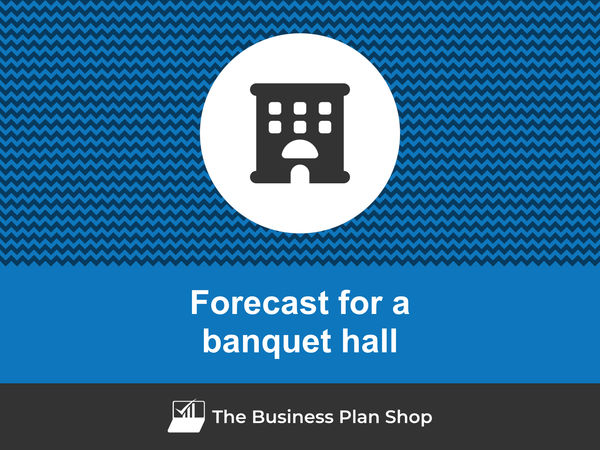
If you are serious about keeping visibility on your future cash flows, then you need to build and maintain a financial forecast for your banquet hall.
Putting together a banquet hall financial forecast may sound complex, but don’t worry, with the right tool, it’s easier than it looks, and The Business Plan Shop is here to guide you.
In this practical guide, we'll cover everything you need to know about building financial projections for your banquet hall.
We will start by looking at why they are key, what information is needed, what a forecast looks like once completed, and what solutions you can use to create yours.
Let's dive in!
Why create and maintain a financial forecast for a banquet hall?
Creating and maintaining an up-to-date financial forecast is the only way to steer the development of your banquet hall and ensure that it can be financially viable in the years to come.
A financial plan for a banquet hall enables you to look at your business in detail - from income to operating costs and investments - to evaluate its expected profitability and future cash flows.
This gives you the visibility needed to plan future investments and expansion with confidence.
And, when your trading environment gets tougher, having an up to date banquet hall forecast enables you to detect potential upcoming financing shortfalls in advance, enabling you to make adjustments or secure financing before you run out of cash.
It’s also important to remember that your banquet hall's financial forecast will be essential when looking for financing. You can be 100% certain that banks and investors will ask to see your numbers, so make sure they’re set out accurately and attractively.
Need a solid financial forecast?
The Business Plan Shop does the maths for you. Simply enter your revenues, costs and investments. Click save and our online tool builds a three-way forecast for you instantly.

What information is used as input to build a banquet hall financial forecast?
A banquet hall's financial forecast needs to be built on the right foundation: your assumptions.
The data required to create your assumptions will depend on whether you are a new or existing banquet hall.
If you are creating (or updating) the forecast of an existing banquet hall, then your main inputs will be historical accounting data and operating metrics, and your team’s view on what to expect for the next three to five years.
If you are building financial projections for a new banquet hall startup, you will need to rely on market research to form your go-to-market strategy and derive your sales forecast.
For a new venture, you will also need an itemised list of resources needed for the banquet hall to operate, along with a list of equipment required to launch the venture (more on that below).
Now that you understand what is needed, let’s have a look at what elements will make up your banquet hall's financial forecast.
The sales forecast for a banquet hall
From experience, it usually makes sense to start your banquet hall's financial projection with the revenues forecast.
The inputs used to forecast your sales will include the historical trading data of your banquet hall (which can be used as a starting point for existing businesses) and the data collected in your market research (which both new ventures and existing businesses need to project their sales forward).
Your banquet hall's sales forecast can be broken down into two key estimates:
- The average price
- The number of monthly transactions
To assess these variables accurately, you will need to consider the following factors:
- Seasonal demand: You may experience fluctuations in your average price and number of monthly transactions based on the season. For example, during peak wedding season in the summer, you may be able to charge a higher average price and have more monthly transactions compared to the slower winter season.
- Economic conditions: The state of the economy can greatly impact your business. During a recession, people may be more inclined to host smaller, budget-friendly events, resulting in a lower average price and number of monthly transactions. Conversely, during a booming economy, people may be willing to spend more on lavish events, leading to a higher average price and more monthly transactions.
- Competition: The presence of other banquet halls in your area can also affect your average price and number of monthly transactions. If there are many competitors offering similar services, you may need to adjust your prices to stay competitive and attract more bookings. On the other hand, if you are the only banquet hall in the area, you may be able to charge higher prices and have a higher number of monthly transactions.
- Relationships with vendors: Your relationships with vendors, such as caterers and decorators, can impact your average price and number of monthly transactions. If you have strong partnerships with these vendors, you may be able to offer package deals and discounts, resulting in a higher average price and more monthly transactions. However, if your relationships are strained, you may have to pay higher prices for these services, leading to a lower average price and fewer monthly transactions.
- Renovations/updates: The physical state of your banquet hall can also affect your business. If your facilities are outdated or in need of repairs, it may be difficult to justify higher prices, resulting in a lower average price and number of monthly transactions. However, if you invest in renovations and updates, you can improve the overall experience for your customers and potentially increase your average price and number of monthly transactions.
Once you have a sales forecast in place, the next step will be to work on your overhead budget. Let’s have a look at that now.
Need inspiration for your business plan?
The Business Plan Shop has dozens of business plan templates that you can use to get a clear idea of what a complete business plan looks like.

The operating expenses for a banquet hall
Once you know what level of sales you can expect, you can start budgeting the expenses required to operate your banquet hall on a daily basis.
Expenses normally vary based on how much revenue you anticipate (which is why, from experience, it is always better to start your forecast with the topline projection), and where your business is based.
Operating expenses for a banquet hall will include some of the following items:
- Staff Costs: This includes salaries, wages, and benefits for all employees working at the banquet hall, such as event coordinators, servers, and kitchen staff.
- Accountancy Fees: These are the fees paid to an accountant or bookkeeper to manage the financial records and taxes for the banquet hall.
- Insurance Costs: This includes general liability insurance, property insurance, and workers' compensation insurance to protect the banquet hall and its employees.
- Software Licences: This refers to the cost of any software used by the banquet hall, such as event management software, accounting software, or reservation systems.
- Banking Fees: These are fees charged by banks for services such as processing credit card payments, wire transfers, and maintaining business accounts.
- Rent: This includes the cost of leasing the banquet hall space, including any additional fees for utilities and maintenance.
- Utilities: This includes the cost of electricity, gas, water, and other utilities used to operate the banquet hall.
- Cleaning and Maintenance: This covers the cost of cleaning supplies, equipment maintenance, and repairs for the banquet hall.
- Marketing and Advertising: This includes the cost of promoting the banquet hall through various channels, such as social media, print ads, and event sponsorships.
- Food and Beverage: This refers to the cost of purchasing food and beverages for events, as well as the cost of any necessary equipment, such as refrigerators and ovens.
- Linens and Decorations: This covers the cost of purchasing and maintaining linens, tableware, and decorations for events.
- Security: This includes the cost of hiring security personnel or installing security systems to ensure the safety of guests and the banquet hall.
- Taxes and Permits: This covers the cost of business taxes, permits, and licenses required to operate a banquet hall.
- Office Supplies: This includes the cost of purchasing office supplies, such as paper, ink, and pens, for administrative tasks.
- Training and Development: This refers to the cost of training programs and workshops for employees to enhance their skills and improve service quality.
This list will need to be tailored to the specificities of your banquet hall, but should offer a good starting point for your budget.
What investments are needed to start or grow a banquet hall?
Once you have an idea of how much sales you could achieve and what it will cost to run your banquet hall, it is time to look into the equipment required to launch or expand the activity.
For a banquet hall, capital expenditures and initial working capital items could include:
- Renovation and Upgrades: This includes any major renovations or upgrades to the banquet hall, such as new flooring, lighting fixtures, or furniture. These expenses are necessary to maintain the appearance and quality of the banquet hall for your customers.
- Kitchen Equipment: A well-equipped kitchen is essential for any banquet hall. This may include items such as commercial refrigerators, ovens, and dishwashers. These capital expenditures are necessary to ensure the smooth operation of your business and to provide high-quality food and service to your customers.
- Audio-Visual Equipment: Many events held in banquet halls require audio-visual equipment for presentations, music, and entertainment. This may include projectors, screens, and sound systems. Investing in quality audio-visual equipment can enhance the experience for your customers and attract more bookings.
- Furniture and Decor: Banquet halls need to have a variety of furniture and decor options to cater to different events and themes. This may include tables, chairs, linens, centerpieces, and other decorative items. These capital expenditures are necessary to create a visually appealing and comfortable atmosphere for your customers.
- Security and Safety Systems: As a business owner, it is your responsibility to ensure the safety and security of your customers and employees. This may include installing security cameras, fire alarms, and emergency exit signs. These capital expenditures are necessary for the overall well-being of your business and to comply with safety regulations.
Again, this list will need to be adjusted according to the specificities of your banquet hall.
Need a convincing business plan?
The Business Plan Shop makes it easy to create a financial forecast to assess the potential profitability of your projects, and write a business plan that’ll wow investors.

The financing plan of your banquet hall
The next step in the creation of your financial forecast for your banquet hall is to think about how you might finance your business.
You will have to assess how much capital will come from shareholders (equity) and how much can be secured through banks.
Bank loans will have to be modelled so that you can separate the interest expenses from the repayments of principal, and include all this data in your forecast.
Issuing share capital and obtaining a bank loan are two of the most common ways that entrepreneurs finance their businesses.
What tables compose the financial plan for a banquet hall?
Now let's have a look at the main output tables of your banquet hall's financial forecast.
The projected profit & loss statement
The projected profit & loss shows how profitable your banquet hall is likely to be in the years to come.
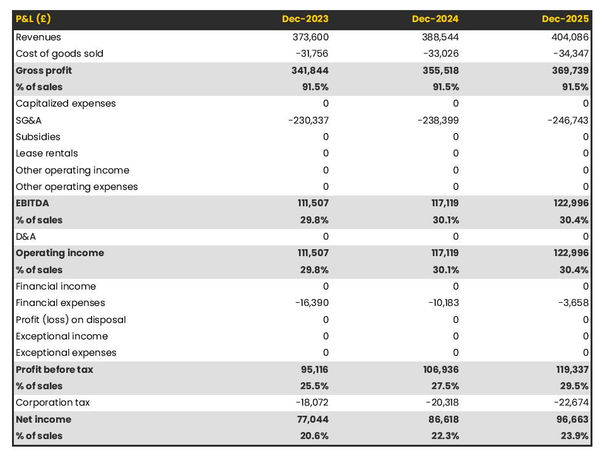
For your banquet hall to be financially viable, your projected P&L should ideally show:
- Sales growing above inflation (the higher the better)
- Profit margins which are stable or expanding (the higher the better)
- A net profit at the end of each financial year (the higher the better)
This is for established banquet halls, there is some leniency for startups which will have numbers that will look a bit different than existing businesses.
The projected balance sheet
The projected balance sheet gives an overview of your banquet hall's financial structure at the end of the financial year.
It is composed of three categories of items: assets, liabilities and equity:
- Assets: are what the business possesses and uses to produce cash flows. It includes resources such as cash, buildings, equipment, and accounts receivable (money owed by clients).
- Liabilities: are the debts of your banquet hall. They include accounts payable (money owed to suppliers), taxes due and bank loans.
- Equity: is the combination of what has been invested by the business owners and the cumulative profits to date (which are called retained earnings). Equity is a proxy for the value of the owner's stake in the business.
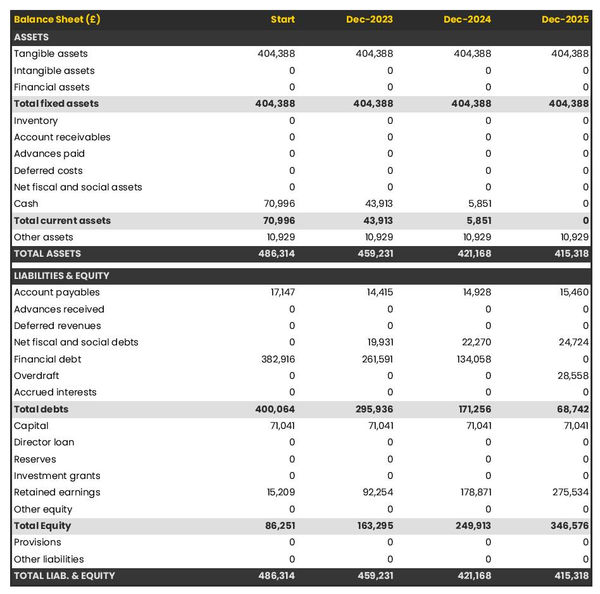
The cash flow projection
The cash flow forecast of your banquet hall will show how much cash the business is expected to generate or consume over the next three to five years.
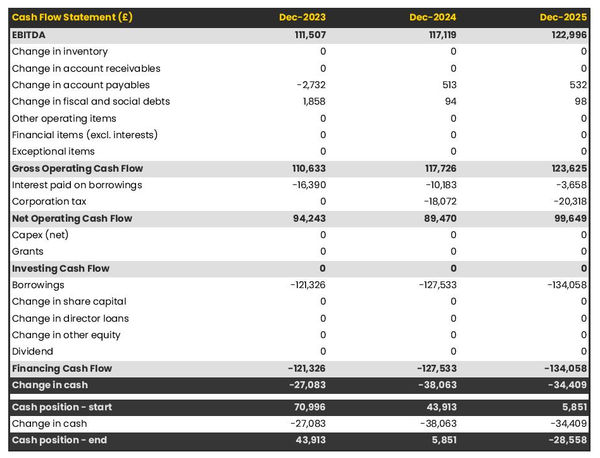
There are multiple ways of presenting a cash flow forecast but from experience, it is better to organise it by nature in order to clearly show these elements:
- Operating cash flow: how much cash is generated by the banquet hall's operations
- Investing cash flow: what is the business investing to expand or maintain its equipment
- Financing cash flow: is the business raising additional funds or repaying financiers (debt repayment, dividends)
Your cash flow forecast is the most important element of your overall financial projection and that’s where you should focus your attention to ensure that your banquet hall is adequately funded.
Note: if you are preparing a financial forecast in order to try to secure funding, you will need to include both a yearly and monthly cash flow forecast in your banquet hall's financial plan.
Need a solid financial forecast?
The Business Plan Shop does the maths for you. Simply enter your revenues, costs and investments. Click save and our online tool builds a three-way forecast for you instantly.

Which tool should you use to create your banquet hall's financial forecast?
Using the right tool or solution will make the creation of your banquet hall's financial forecast much easier than it sounds. Let’s explore the main options.
Using online financial forecasting software to build your banquet hall's projections
The modern and easiest way is to use an online financial forecasting tool such as the one we offer at The Business Plan Shop.
There are several advantages to using specialised software:
- You can easily create your financial forecast by letting the software take care of the financial calculations for you without errors
- You have access to complete financial forecast templates
- You get a complete financial forecast ready to be sent to your bank or investors
- You can easily track your actual financial performance against your financial forecast, and recalibrate your forecast as the year goes by
- You can create scenarios to stress test your forecast's main assumptions
- You can easily update your forecast as time goes by to maintain visibility on future cash flows
- You have a friendly support team on standby to assist you when you are stuck
- It’s cost-efficient and much cheaper than using an accountant or consultant (see below)
If you are interested in this type of solution, you can try our projection software for free by signing up here.
Calling in a financial consultant or chartered accountant
Enlisting the help of a consultant or accountant is also a good way to obtain a professional banquet hall financial forecast.
The downside of this solution is its cost. From experience, obtaining a simple financial forecast over three years (including a balance sheet, income statement, and cash flow statement) is likely to cost a minimum of £700 or $1,000.
The indicative cost above, is for a small business, and a forecast is done as a one-shot exercise. Using a consultant or accountant to track your actuals vs. forecast and to keep your financial projections up to date on a monthly or quarterly basis will cost a lot more.
If you opt for this solution, make sure your accountant has in-depth knowledge of your industry, so that they may challenge your figures and offer insights (as opposed to just taking your assumptions at face value to create the forecast).
Why not use a spreadsheet such as Excel or Google Sheets to build your banquet hall's financial forecast?
You and your financial partners need numbers you can trust. Unless you have studied finance or accounting, creating a trustworthy and error-free banquet hall financial forecast on a spreadsheet is likely to prove challenging.
Financial modelling is very technical by nature and requires a solid grasp of accounting principles to be done without errors. This means that using spreadsheet software like Excel or Google Sheets to create accurate financial forecasts is out of reach for most business owners.
Creating forecasts in Excel is also inefficient nowadays:
- Software has advanced to the point where forecasting can be done much faster and more accurately than manually on a spreadsheet.
- With artificial intelligence, the software is capable of detecting mistakes and helping decision-making.
Spreadsheets are versatile tools but they are not tailor-made for reporting. Importing your banquet hall's accounting data in Excel to track actual vs. forecast is incredibly manual and tedious (and so is keeping forecasts up to date). It is much faster to use dedicated financial planning tools like The Business Plan Shop which are built specially for this.
Need a convincing business plan?
The Business Plan Shop makes it easy to create a financial forecast to assess the potential profitability of your projects, and write a business plan that’ll wow investors.

Use our financial forecast templates for inspiration
The Business Plan Shop has dozens of financial forecast examples available.
Our templates contain both a financial forecast and a written business plan which presents, in detail, the company, the team, the strategy, and the medium-term objectives.
Our templates are a great source of inspiration, whether you just want to see what a complete business plan looks like, or are looking for concrete examples of how you should model financial elements in your own forecast.
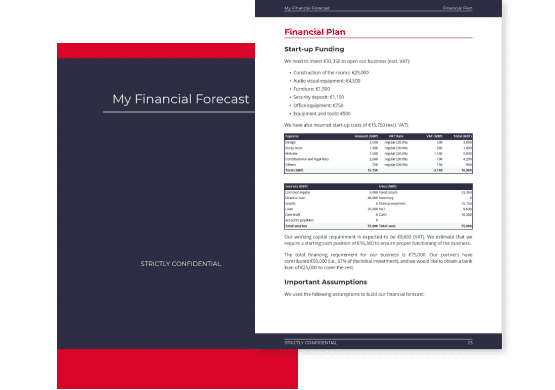
Takeaways
- Having a financial forecast enables you to visualise the expected growth, profitability, and cash generation for your business over the next three to five years.
- Tracking actuals vs. forecast and keeping your financial projections up-to-date is the only way to get a view on what your banquet hall future cash flows may look like.
- Using financial forecasting software is the mordern and easy way to create and maintain your forecasts.
This is the end of our guide on how to build the financial forecast for a banquet hall, we hope you found it useful. Don't hesitate to contact us if you want to share your feedback or have any questions.
Need inspiration for your business plan?
The Business Plan Shop has dozens of business plan templates that you can use to get a clear idea of what a complete business plan looks like.

Also on The Business Plan Shop
Know someone who owns or is thinking of starting a banquet hall? Share our forecasting guide with them!



